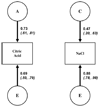Twin study of the heritability of recognition thresholds for sour and salty taste - PubMed (original) (raw)
Twin study of the heritability of recognition thresholds for sour and salty taste
Paul M Wise et al. Chem Senses. 2007 Oct.
Abstract
Seventy-four pairs of monozygotic (identical) twins and 35 pairs of dizygotic (fraternal) twins provided recognition thresholds (modified Harris-Kalmus test) for the sourness of citric acid and the saltiness of sodium chloride during the Twins Days Festival in Twinsburg, OH. Variance components (ACE) models were applied to the data: total variation = additive genetic (A) + common environment (C) + nonshared environment (E). The best-fit model of variation in recognition thresholds for sourness included an additive genetic factor, accounting for 53% of the variance, but no common environment component. This level of heritability, on par with that of sensitivity to the bitter compounds 6-n-propylthiouracil and phenylthiocarbamide, strongly suggests that genetic factors play a larger role than shared environment in determining individual differences in recognition thresholds for sourness. In contrast, the best-fit model for saltiness recognition included a common environment component, accounting for 22% of the variance in thresholds, but no additive component. This result suggests that environment plays a larger role than genetics in determining individual differences in recognition thresholds for saltiness.
Figures
Figure 1
Standardized path diagram depicting the additive genetic (A), common environmental (C), and unique environmental (E) variation in recognition thresholds for CA and NaCl. Standardized path coefficients (which should be squared to obtain proportion of variance accounted for) are shown, with 95% Cls in parentheses.
Similar articles
- Genetic contribution to sour taste preference.
Törnwall O, Silventoinen K, Keskitalo-Vuokko K, Perola M, Kaprio J, Tuorila H. Törnwall O, et al. Appetite. 2012 Apr;58(2):687-94. doi: 10.1016/j.appet.2011.12.020. Epub 2012 Jan 4. Appetite. 2012. PMID: 22245130 - Phenylthiocarbamide tasting in a sample of twins.
Martin NG. Martin NG. Ann Hum Genet. 1975 Jan;38(3):321-6. doi: 10.1111/j.1469-1809.1975.tb00616.x. Ann Hum Genet. 1975. PMID: 1169903 - A genetic analysis of taste threshold for phenylthiocarbamide.
Morton CC, Cantor RM, Corey LA, Nance WE. Morton CC, et al. Acta Genet Med Gemellol (Roma). 1981;30(1):51-7. doi: 10.1017/s0001566000006619. Acta Genet Med Gemellol (Roma). 1981. PMID: 7199800 - Taste perception for phenylthiocarbamide and food choice--a Hungarian twin study.
Forrai G, Bánkövi G. Forrai G, et al. Acta Physiol Hung. 1984;64(1):33-40. Acta Physiol Hung. 1984. PMID: 6541419
Cited by
- Individual differences in sour and salt sensitivity: detection and quality recognition thresholds for citric acid and sodium chloride.
Wise PM, Breslin PA. Wise PM, et al. Chem Senses. 2013 May;38(4):333-42. doi: 10.1093/chemse/bjt003. Epub 2013 Feb 14. Chem Senses. 2013. PMID: 23413310 Free PMC article. - Nutrition and taste and smell dysfunction.
Kershaw JC, Mattes RD. Kershaw JC, et al. World J Otorhinolaryngol Head Neck Surg. 2018 Mar 23;4(1):3-10. doi: 10.1016/j.wjorl.2018.02.006. eCollection 2018 Mar. World J Otorhinolaryngol Head Neck Surg. 2018. PMID: 30035256 Free PMC article. Review. - Exploring Associations between Interindividual Differences in Taste Perception, Oral Microbiota Composition, and Reported Food Intake.
Cattaneo C, Riso P, Laureati M, Gargari G, Pagliarini E. Cattaneo C, et al. Nutrients. 2019 May 24;11(5):1167. doi: 10.3390/nu11051167. Nutrients. 2019. PMID: 31137674 Free PMC article. - Salt need needs investigation.
Leshem M. Leshem M. Br J Nutr. 2020 Jun 14;123(11):1312-1320. doi: 10.1017/S0007114520000173. Epub 2020 Jan 21. Br J Nutr. 2020. PMID: 31959267 Free PMC article. Review. - Taste Responses to Linoleic Acid: A Crowdsourced Population Study.
Garneau NL, Nuessle TM, Tucker RM, Yao M, Santorico SA, Mattes RD; Genetics of Taste Lab Citizen Scientists. Garneau NL, et al. Chem Senses. 2017 Oct 31;42(9):769-775. doi: 10.1093/chemse/bjx058. Chem Senses. 2017. PMID: 28968903 Free PMC article.
References
- Ayya N, Beauchamp GK. Short-term effects of diet on salt taste preferences. Appetite. 1992;18:77–82. - PubMed
- Beauchamp GK, Bertino M, Engelman K. Sensory basis for human salt consumption. In: Horan MJ, Blaustein MP, Dunbar JB, Kachadorian W, Kaplan NM, Simopoulos AP, editors. NIH Workshop on Nutrition and Hypertension Proceedings from a Symposium; 1984 March 12–14; Bethesda, MD. New York. Biomedical Information Corporation; 1985.
- Beauchamp GK, Fisher AS. Strain differences in consumption of saline solutions by mice. Physiol Behav. 1993;54:179–184. - PubMed
Publication types
MeSH terms
Substances
Grants and funding
- R01DC002995/DC/NIDCD NIH HHS/United States
- R03ES013969/ES/NIEHS NIH HHS/United States
- R01 DC002995/DC/NIDCD NIH HHS/United States
- R01 DC004698/DC/NIDCD NIH HHS/United States
- R01DC004698/DC/NIDCD NIH HHS/United States
- R01 DC004698-03/DC/NIDCD NIH HHS/United States
- R03 ES013969/ES/NIEHS NIH HHS/United States
- R03 DC003509/DC/NIDCD NIH HHS/United States
LinkOut - more resources
Full Text Sources
Miscellaneous
